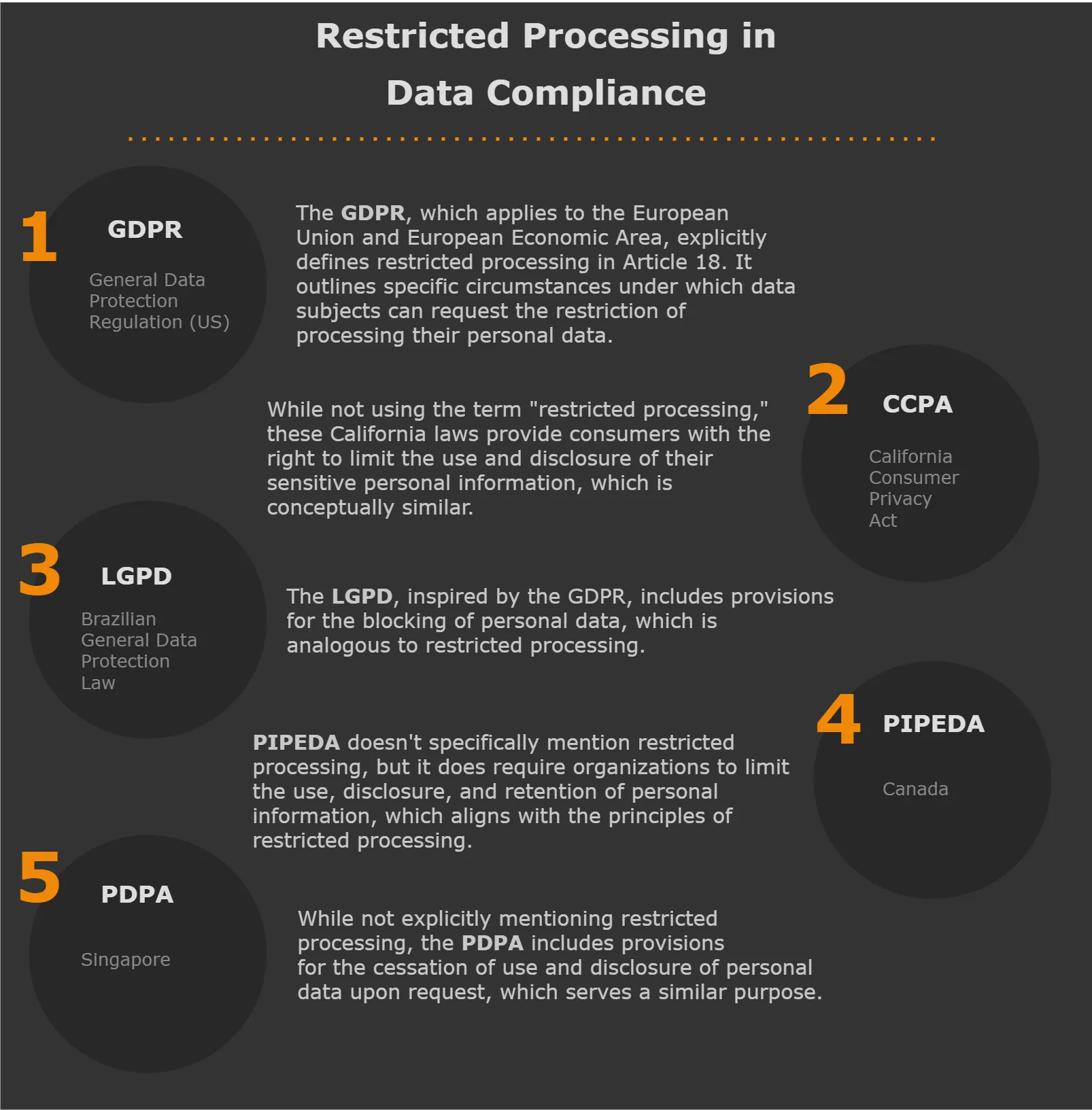
Restricted Processing

As the data becomes more and more important in our life, organizations face increasing pressure to handle personal information responsibly. One crucial aspect of data protection regulations is the concept of restricted processing. This article discusses restricted processing in data compliance and how businesses can use open-source tools for effective data management strategies.
What is Restricted Processing in Data Regulations?
This processing is important in data protection laws, like the GDPR, to control how personal data is handled. It refers to the limitation of data processing activities under specific conditions. This practice ensures that organizations handle personal data ethically and in compliance with legal requirements.
When Does It Apply?
Several scenarios may trigger restricted processing.
- When an individual contests the accuracy of their personal data
- When the processing is unlawful, but the data subject opposes erasure
- When the data controller no longer needs the data, but the data subject requires it for legal claims
- When the data subject has objected to processing, pending verification of the controller’s legitimate grounds
In these cases, organizations must limit their data processing activities to storage only, unless they have the data subject’s consent or other legal grounds to continue processing.

Controlling Data When Processing Must Stop
Organizations need to act swiftly to comply when they receive a request for restricted processing. Here are some approaches to control data processing:
1. Data Isolation
One effective method is to isolate the affected data. You can do this by:
- Moving the data to a separate, restricted-access database
- Applying access controls to limit who can view or modify the data
- Temporarily removing the data from active systems
2. Flagging Systems
Implementing a flagging system can help mark data for restricted processing:
- Add a “restricted processing” flag to relevant database records
- Use metadata tags to indicate processing limitations
- Implement system alerts that notify users when attempting to access restricted data
3. Process Modification
Adjusting existing processes is crucial:
- Update data flows to exclude restricted data
- Modify reporting tools to omit flagged information
- Implement checks in data processing pipelines to skip restricted data
Open-Source Tools for Restricted Processing
Several open-source tools can aid in implementing processing of restricted data:
1. Apache Atlas
Apache Atlas is a data governance and metadata framework that can help with data discovery and classification.
Example:
# Create a new classification for processing restricted data atlas entity-def create --filename restricted_processing_classification.json # Apply the classification to a specific dataset atlas entity update --guid <entity_guid> --classification RESTRICTED_PROCESSING
Result: This creates a new classification for restricted processing and applies it to a specific dataset, making it easier to track and manage restricted data.
2. OpenRefine
OpenRefine is a powerful tool for data cleaning and transformation that can help identify and manage restricted data.
Example:
Create a text facet to identify potentially restricted data
- Click on the column containing personal data
- Choose Facet > Text facet
- Review the facet results to identify data requiring restriction
Flag rows for restricted processing
- Create a new column based on the personal data column
- Use the following GREL expression:
if(value.contains("sensitive_info"), "RESTRICTED", "NORMAL")Result: This creates a new column flagging rows that contain sensitive information for restricted processing.
3. PostgreSQL
PostgreSQL, an open-source relational database, offers features that can be used to implement restricted processing.
Example:
-- Create a table with a restricted processing flag CREATE TABLE user_data ( id SERIAL PRIMARY KEY, name TEXT, email TEXT, is_restricted BOOLEAN DEFAULT FALSE ); -- Set up a view that excludes restricted data CREATE VIEW active_user_data AS SELECT * FROM user_data WHERE NOT is_restricted; -- Create a function to toggle restricted processing CREATE OR REPLACE FUNCTION toggle_restricted_processing(user_id INT, restrict BOOLEAN) RETURNS VOID AS $$ BEGIN UPDATE user_data SET is_restricted = restrict WHERE id = user_id; END; $$ LANGUAGE plpgsql;
Result: This setup creates a table with a flag for restricted processing, a view that only shows non-restricted data, and a function to easily toggle the restricted status of a user’s data.
Implementing Safe Data Deletion
When data subjects request deletion, it’s crucial to ensure that the process is thorough and irreversible. Here are some approaches:
1. Soft Deletion
Soft deletion involves marking records as deleted without physically removing them from the database. This can be useful for audit trails and complying with retention policies.
Example (using PostgreSQL):
-- Add a deleted_at column to the user_data table ALTER TABLE user_data ADD COLUMN deleted_at TIMESTAMP; -- Create a function for soft deletion CREATE OR REPLACE FUNCTION soft_delete_user(user_id INT) RETURNS VOID AS $$ BEGIN UPDATE user_data SET deleted_at = NOW() WHERE id = user_id; END; $$ LANGUAGE plpgsql; -- Create a view of active (non-deleted) users CREATE VIEW active_users AS SELECT * FROM user_data WHERE deleted_at IS NULL;
Result: This setup allows for soft deletion of user data, maintaining a record of when the deletion occurred while effectively removing the data from active use.
2. Secure Physical Deletion
For cases where physical deletion is necessary, ensure that data is overwritten to prevent recovery.
Example (using Linux shred command):
# Securely delete a file shred -u -z /path/to/sensitive_file.txt
Result: This command overwrites the file multiple times before deleting it, making recovery extremely difficult.
Data Discovery for Effective Restricted Processing
Implementing restricted processing effectively requires a thorough understanding of where personal data resides within your systems. Data discovery tools can help identify and classify sensitive information.
Open-Source Data Discovery Tools
- Amundsen: A data discovery and metadata engine developed by Lyft.
- DataHub: LinkedIn’s generalized metadata search & discovery tool.
Example (using DataHub):
# Ingest metadata from a PostgreSQL database datahub ingest -c postgresql_to_datahub.yml # Search for potentially sensitive data datahub cli search "email" --entity_type dataset
Result: This process ingests metadata from a PostgreSQL database into DataHub. It also allows searching for potentially sensitive fields like email addresses across all ingested datasets.
Balancing Data Utility and Compliance
While implementing restricted processing, it’s crucial to maintain a balance between data protection and business utility. Here are some strategies:
- Data Minimization: Collect and retain only the data necessary for your business purposes.
- Purpose Limitation: Explicitly outline and record the reasons for which you process the data.
- Regular Audits: Conduct periodic reviews of your data processing activities to ensure ongoing compliance.
- Employee Training: Educate staff on the importance of data protection and the procedures for handling restricted processing requests.
Conclusion
Restricted processing is a critical component of modern data protection regulations. Organizations can follow rules and use good plans to keep their data safe and follow the law. This article discusses how to use open-source tools and techniques to build robust data management systems. These systems must comply with privacy laws and regulations.
As data protection laws change, it’s important to stay informed and flexible in how you handle restricted processing. This will help you maintain trust with your customers and avoid legal issues.
For user-friendly and flexible tools designed to enhance database security and ensure compliance, consider exploring DataSunrise’s suite of solutions. Visit our website at DataSunrise for an online demo and discover how we can help streamline your data protection efforts.
